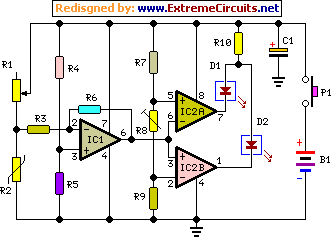- Temperature-Controlled Switch
- Energy Leak Detector Circuit Diagram
- Heating System Thermostat Circuit
- Fridge-Door Open Alarm Circuit Project
- Fridge Door Alarm Schematic 2nd Version
- Fridge Door Alarm Circuit
- Fire Alarm Using Thermistor
- Electronic Thermostat and Relay Circuit
- Temperature Monitor
- Heating System Thermostat
- Fridge door Alarm
- Frost Alarm
- Temperature-controlled Fan
- On-Off Temperature Control
- Hot Water Level Indicator
Energy Leak Detector Circuit Diagram
Description
This sensitive circuit is basically a comparator, detecting very slight temperature changes in respect to the ambient temperature. It was primarily intended to detect draughts around doors and windows that cause energy leaks but can be used in many other ways, when a sensitive temperature change detector is needed. Two LEDs are used to signal if the temperature change is pointing above (Red LED) or below (Green LED) the ambient temperature.
Circuit operation:
IC1 acts as a bridge detector and amplifier: its output voltage raises when temperature increases and vice-versa. This happens because the n.t.c. resistor R2 reduces its resistance value as temperature increases and vice-versa, therefore unbalancing the bridge formed by R1, R2, R4, R5. IC2A and IC2B form a window comparator and R8 is the sensitivity control. Before starting a measurement the circuit must be balanced by means of R1 in order to obtain that both LEDs are off. If R8 is set to zero resistance the circuit sensitivity will be at maximum and one of the LEDs will illuminate when a very slight difference in temperature will be detected. As R8 value is increased the circuit sensitivity will decrease.
Circuit diagram:
Parts:
- R1 = 22K - Linear Potentiometer (See Notes)
- R2 = 15K @ 20°C n.t.c. Thermistor (See Notes)
- R3 = 10K - 1/4W Resistor
- R4 = 22K - 1/4W Resistor
- R5 = 22K - 1/4W Resistor
- R6 = 220K - 1/4W Resistor
- R7 = 22K - 1/4W Resistor
- R8 = 5K - 1/2W Trimmer Cermet
- R9 = 22K - 1/4W Resistor
- R10 = 680R - 1/4W Resistor
- C1 = 47µF - 63V Electrolytic Capacitor
- D1 = 5mm. Red LED
- D2 = 5mm. Green LED
- IC1 = TL061 Low current BIFET Op-Amp
- IC2 = LM393 Dual Voltage Comparator IC
- P1 = SPST Pushbutton
- B1 = 9V PP3 Battery
Notes:
- The Thermistor value can be chosen in the 10K - 22K @ 20°C range.
- R1 value should be about twice the Thermistor value @ 20°C, so using a 22K Thermistor a 47K potentiometer should be used.
- To ensure fast detection of temperature changes, the use of a Thermistor having the case as small as possible is recommended.
- If only one LED is needed to show a change in temperature, no matter if raising or decreasing, D2 can be omitted and pin #1 of IC2B must be connected to pin #7 of IC2A.
